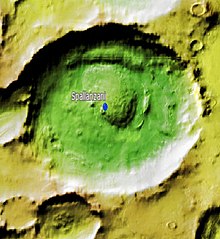Spallanzani (Martian crater)
 Stair-stepping mesas in interior deposit of Spallanzani Crater, as seen by THEMIS. | |
| Planet | Mars |
|---|---|
| Coordinates | 58°00′S 86°24′E / 58.0°S 86.4°E |
| Quadrangle | Hellas |
| Diameter | 71.69 km |
| Eponym | Lazzaro Spallanzani, an Italian biologist (1729–1799) |
Spallanzani is a crater on Mars, located in the Hellas quadrangle at 58.0° south latitude and 86.4° east longitude. It measures approximately 72 kilometers in diameter and was named after Italian biologist Lazzaro Spallanzani (1729–1799). The name was adopted by IAU's Working Group for Planetary System Nomenclature in 1973.[1]
Description
Pictures from orbiting spacecraft have shown many layers on the floor of the crater.
-
Spallanzani Crater with layers, as seen by CTX camera (on Mars Reconnaissance Orbiter).
-
Layers in Spallanzani Crater, as seen by CTX camera (on Mars Reconnaissance Orbiter). Note: this is an enlargement of the northern side of previous image.

Many places on Mars show rocks arranged in layers. Rock can form layers in a variety of ways. Volcanoes, wind, or water can produce layers.[2]
Many craters once contained lakes.[3][4][5] Because some crater floors show deltas, we know that water had to be present for some time. Dozens of deltas have been spotted on Mars.[6] Deltas form when sediment is washed in from a stream entering a quiet body of water. It takes a bit of time to form a delta, so the presence of a delta is exciting; it means water was there for a time, maybe for many years. Primitive organisms may have developed in such lakes; hence, some craters may be prime targets for the search for evidence of life on the Red Planet.[7]
See also
References
- ^ "Gazetteer of Planetary Nomenclature | Spallanzani". usgs.gov. International Astronomical Union. Retrieved 4 March 2015.
- ^ "HiRISE | High Resolution Imaging Science Experiment". Hirise.lpl.arizona.edu?psp_008437_1750. Retrieved 2012-08-04.
- ^ Cabrol, N. and E. Grin. 2001. The Evolution of Lacustrine Environments on Mars: Is Mars Only Hydrologically Dormant? Icarus: 149, 291-328.
- ^ Fassett, C. and J. Head. 2008. Open-basin lakes on Mars: Distribution and implications for Noachian surface and subsurface hydrology. Icarus: 198, 37-56.
- ^ Fassett, C. and J. Head. 2008. Open-basin lakes on Mars: Implications of valley network lakes for the nature of Noachian hydrology.
- ^ Wilson, J. A. Grant and A. Howard. 2013. INVENTORY OF EQUATORIAL ALLUVIAL FANS AND DELTAS ON MARS. 44th Lunar and Planetary Science Conference.
- ^ Newsom H. , Hagerty J., Thorsos I. 2001. Location and sampling of aqueous and hydrothermal deposits in martian impact craters. Astrobiology: 1, 71-88.


